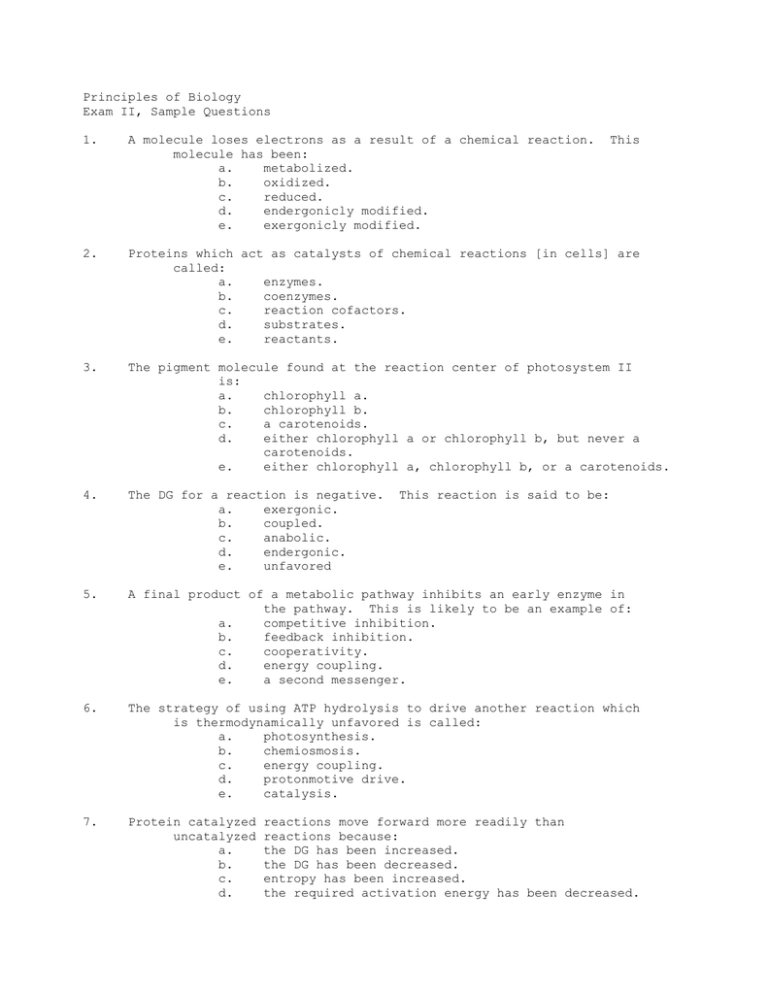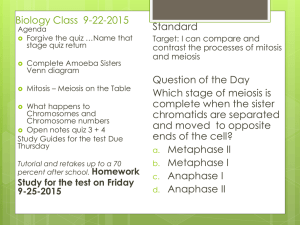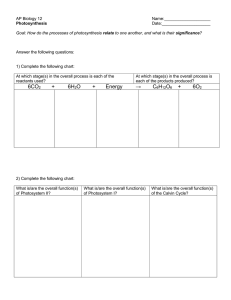Principles of Biology Exam II, Sample Questions 1.
advertisement

Principles of Biology Exam II, Sample Questions 1. A molecule loses electrons as a result of a chemical reaction. molecule has been: a. metabolized. b. oxidized. c. reduced. d. endergonicly modified. e. exergonicly modified. This 2. Proteins which act as catalysts of chemical reactions [in cells] are called: a. enzymes. b. coenzymes. c. reaction cofactors. d. substrates. e. reactants. 3. The pigment molecule found at the reaction center of photosystem II is: a. chlorophyll a. b. chlorophyll b. c. a carotenoids. d. either chlorophyll a or chlorophyll b, but never a carotenoids. e. either chlorophyll a, chlorophyll b, or a carotenoids. 4. The DG for a reaction is negative. a. exergonic. b. coupled. c. anabolic. d. endergonic. e. unfavored 5. A final product of a metabolic pathway inhibits an early enzyme in the pathway. This is likely to be an example of: a. competitive inhibition. b. feedback inhibition. c. cooperativity. d. energy coupling. e. a second messenger. 6. The strategy of using ATP hydrolysis to drive another reaction which is thermodynamically unfavored is called: a. photosynthesis. b. chemiosmosis. c. energy coupling. d. protonmotive drive. e. catalysis. 7. Protein catalyzed uncatalyzed a. b. c. d. This reaction is said to be: reactions move forward more readily than reactions because: the DG has been increased. the DG has been decreased. entropy has been increased. the required activation energy has been decreased. e. entropy has been decreased. _______________________________________________________________________ Using the energy profile for the reaction above, match the following: 8. Activation energy 9. DG 10. Free energy of reactants 11. Free energy of products 12. The reaction depicted above has a DG which is: a. positive. b. negative. c. Since it is enzyme catalyzed, DG is near zero. _______________________________________________________________________ 13. The second law of thermodynamics states that for chemical reactions: a. entropy always increases. b. entropy always decreases. c. free energy always increases. d. free energy always decreases. e. anabolic reactions must always be paired with catabolic reactions. 14. An example of a cellular junction which is involved in cell to cell communication is a/an: a. gap junction. b. desmosome. c. tight junction. d. peroxisome. e. stomata. 15. The overall process of converting glucose to carbon dioxide plus water has a DG which is: a. b. c. d. e. strongly positive. strongly negative. near zero. weakly positive. positive but driven by ATP hydrolysis. 16. Fermentation is different than respiration in that it does not require: a. ADP. b. NAD. c. oxygen. d. a carbon source like glucose. e. oxidation. 17. The electron transport chain utilized to make ATP during photosynthesis by plants is located in the: a. stroma. b. thylakoid membrane. c. inner chloroplast membrane. d. outer chloroplast membrane. e. plasma membrane. 18. The electrons associated with the hydrogens of which of the following molecules would be expected to be at the lowest relative energy level? a. a carbon of glucose b. carried by NADH c. carried by FADH2 d. H20 e. a carbon of pyruvate NADH and FADH2 are examples of: a. electron donors. b. oxidizing compounds. c. photosynthetic pigments. d. electron acceptors. e. competitive inhibitors. 19. 20. The Calvin cycle: a. produces NADPH and ATP by substrate level phosphorylation. b. produces a proton gradient for synthesizing ATP. c. uses ATP and NADPH to synthesize sugars. d. pumps carbon dioxide into the bundle sheath cells. e. uses solid rubber tires. 21. CAM plants have adapted to: a. low carbon dioxide levels in the atmosphere. b. arid climates. c. ATP production at low proton gradients. d. fix carbon as a 3 carbon acid. e. carry out the light reaction in the dark. 22.In CAM plants the Calvin cycle reactions of photosynthesis occur: a. at night. b. during the day. c. at the same time as the light reactions. d. Answers ÒbÓ and ÒcÓ are both true. e. 23. CAM plants do not photosynthesize. The electrons used for noncyclicphotophosphorylation by photosystem II in green plants are derived from: a. water. b. carbon dioxide. c. NADH. d. NADPH. e. rubisco. 24. Cyclic phosphorylation produces _______ and is carried out by ____ (only the photosystem, not electron transport chain, is included). a. NADPH, photosystem I. b. ATP, photosystem I. c. NADPH, photosystem II. d. ATP, photosystem II. e. NADH, photosystems I and II. 25. 26. The net yield of ATP from a glucose molecule being metabolized through glycolysis to pyruvate is ______ molecule(s) . a. 1 b. 2 c. 4 d. 36 e. 42 Glycolysis occurs: a. on the plasma membrane. b. on the mitochondrial inner membrane. c. in the mitochondrial matrix. d. in the mitochrondrial intermembrane space. e. in the cytoplasm. 27. In addition to ATP, glycolysis produces: a. GTP. b. NADH. c. lactate. d. FADH2. e. a proton gradient across the membrane. 28. Active site is the term used to describe the location where: a. chemiosmosis occurs. b. the dark reactions of photosynthesis occur. c. water is split during photosynthesis. d. chromosomes migrate along the microtubules during mitosis. e. substrates bind to enzymes and catalysis occurs. 29. At what point during cell division does synapsis occur? a. prophase I of meiosis b. telophase I of meiosis c. metaphase II of meiosis d. prophase of mitosis e. anaphase I of meiosis 30. The enzyme which fixes carbon dioxide in C3 plants as the first step in the Calvin cycle is: a. b. c. d. e. PEP carboxylase. glucose kinase. pyruvate synthetase CAM synthetase rubisco 31. In which phase of meiosis do the homologous chromosomes undergo separation? a. metaphase I b. anaphase II c. prophase I d. metaphase II e. anaphase I 32. During which phase of meiosis are the tetrads of homologous chromosomes aligned at the center of the dividing cell? a. prophase I b. metaphase I c. anaphase II d. anaphase I e. metaphase II During which phase of meiosis do the centromeres uncouple and sister chromatids separate? a anaphase I b. prophase II c. metaphase II d. anaphase II e. metaphase I 33. 34. Between the metaphases of meiosis I and meiosis II,: a. there is a full cell cycle. b. there is an extended G1 period. c. the nuclear membranes do not reform. d. a decrease in chromosome number has occurred. e. a single round of DNA replication is carried out. 35. A type of junction which seals cells together to form a barrier to fluid movement through a layer of cells [e.g. through the intestinal epithelium] is called a: A. tight junction. B. desmosome. C. hemidesmosome. D. chiasma. E. gap junction. 36. EGF and PDGF are examples of: A. glycolytic intermediates. B. enzymes in the glycolytic pathway. C. growth factors. D. tumor suppressors. E. cyclins. 37. A class of genes which are commonly involved in the inherited increased risk for cancer are the: A. oncogenes. B. protooncogenes. C. cyclins. D. E. growth factors. tumor suppressors. 38. ATP is synthesized by ATP synthase in the mitochondria by the process of: A. chemiosmosis. B. electron transport. C. substrate level phosphorylation. D. oxidative phosphorylation. E. redox reactions. 39. An example of an anchoring junction, which can hold two cells together and anchor filaments or other structures to the inside of the plasma membrane is a: A. tight junction. B. desmosome. C. gap junction. D. centrosome. E. rivetosome. 40. A human gamete has: A. 23 chromosomes. B. 46 chromosomes (23 pairs). C. 46 chromosomes. D. 23 autosomes. E. two sex chromosomes. 41. The two sister chromatids of a eukaryotic chromosome are connected at the: A. centromere. B. centriole. C. chiasma. D. telomere. E. centrosome. 42. DNA replication occurs in eukaryotic cells during: a. G1 phase. b. S phase. c. G2 phase. d. mitosis. e. G0 phase. 43. Germline cells produce: a. most of the organs in the human body. b. important structures in plants but are not formed in animals. c. hormones. d. antibodies to fight disease in higher eukaryotes. e. gametes. 44. The pairing of homologous chromosomes during meiosis is called: a. partitioning. b. synapsis. c. chiasma. d. pleiotropy. e. epistasis. 45. 46. Sexual life cycles produce genetic variation in offspring by: a. independent assortment of chromosomes. b. crossing over between nonsister chromatids. c. random fertilization. d. Only two of the above answers are correct e. All of the above answers are correct. Gametes are examples of: a. haploid cells. b. somatic cells. c. diploid cells. d. the products of mitotic division. e. things your parents donÕt want to talk about. 47. Which of the following is/are NOT involved in intracellular signaling cascades? a. cAMP b. adenylate cyclase c. G proteins d. potassium e. protein kinases 48. Genes which can contribute in a dominant fashion to a cell becoming cancerous are called: a. oncogenes. b. protooncogenes. c. mutagens. d. tumor suppressors. e. carcinogenes. 49. Cyclic AMP (cAMP) a. b. c. d. e. 50. The Calvin cycle (dark reactions) of photosynthesis occurs in the: a. thylakoids. b. grana. c. cytoplasm. d. chloroplast stroma. e. mitochondrial matrix. 51. The molecules which regulate the cdk enzymes controlling the cell cycle are called: a. second messengers. b. hormones. c. cyclins. d. cAMPs. e.check point modulators. 52. The final acceptor for the mitochondrial electron transport chain is: a. water. b. oxygen. c. NAD. d. ATP. is an example of a/an: hormone. electron acceptor. electron donor. high energy phosphate donor. second messenger 53. e. ADP. A pathway produces an amino acid as a final product. example of: a. a catabolic pathway. b. an anabolic pathway. c. a heterotrophic pathway. d. an autotrophic pathway. e. allosteric production. This is an 54. The electrons from NADH, when fed through the electron transport chain of mitochondria, provide a theoretical yield of: a. 1 ATP. b. 2 ATP. c. 3 ATP. d. 4 ATP. e. 1 oxygen. 55. Fatty acids are metabolized by: a. channeling them into the clycolytic pathway. b. the Calvin cycle. c. channeling them into the KrebÕs cycle. d. channeling them directly into the electron transport chain. e. deamination.




